-
Posts
13,352 -
Joined
-
Last visited
Content Type
Profiles
Forums
Gallery
Events
Everything posted by druxey
-
Is the difference in leg length related to the deadeye on the long strop (your original post, photos 2 and 3)?
-

La Belle: Archaeology of a Seventeenth-Century Ship
druxey replied to bruce d's topic in Nautical/Naval History
I can't keep up with all the reading that you are supplying, Bruce! This is fascinating stuff. Thank you. -
Nicely and sympathetically done, with a great result!
- 71 replies
-
- great harry
- henry grace a dieu
-
(and 3 more)
Tagged with:
-
Much more like the contemporary models with the rail abutting the step!
- 857 replies
-
- Sphinx
- Vanguard Models
-
(and 1 more)
Tagged with:
-
Hopefully we can answer your questions, Mike.
-
Now, those are crowsfeet! Well done. At the risk of being a pain, can you shape them mouses a little more mouse-like? (Hint: stays go over the shrouds. See photo.)
- 542 replies
-
- Sphinx
- Vanguard Models
-
(and 3 more)
Tagged with:
-
You have the right idea. The lower deadeyes still have their laniards in place in your last photo. The upper deadeyes were attached as you see them, with a metal sheerpole lashed just above to keep the upper deadeyes from twisting around. The longer stropped lower deadeye must be for something else; perhaps a topmast stay? The shroud pair was looped over the mast head and this appears to have the lashing below the loop still in place. There are remains of the ratlines still there, so that will act as a pattern for spacing the replacements. I imagine the rigging is now brittle so should all be replaced. An interesting project!
-

Woolwich Royal Dockyard archaeological investigations
druxey replied to bruce d's topic in Nautical/Naval History
Very informative. Thank you, Bruce! -
This from BBC: https://www.bbc.com/future/article/20220426-battle-of-the-aegates-the-shipwrecks-rewriting-roman-history It's quite a story of the discovery of the site of this battle and recovered artifacts.
-
Lovely. Good luck with the cathead supporters. Those are the hardest pieces in the ship to make!
-

Swan-Class Sloop by Stuglo - FINISHED - 1:48
druxey replied to stuglo's topic in - Build logs for subjects built 1751 - 1800
Looks a bit like convolvulus. However, a botanical expert may know better!- 475 replies
-
The issue with square-hole drawplates is that they are designed for pulling metal wire through. It essentially squeezes metal; it doesn't cut. Wood needs to be cut or shaved; it really doesn't squeeze well! That is why a drawplate for wood, such as the Byrnes' is of a different form than a traditional jewelers' drawplate. I don't know of such a square drawplate design on the market.
-

Planking Primer.pdf
druxey replied to rudybob's topic in Building, Framing, Planking and plating a ships hull and deck
As Allan wrote, you can edge bend, but within limits. -
Much grist for your mill, Sam!
-
Nice neat job on the reef points! Looking very good.
- 90 replies
-
- Model Shipways
- muscongus bay lobster smack
-
(and 1 more)
Tagged with:
-
Looks much more convincing, Meriadoc. However, I really wonder if a topgallant yard and sail was fitted. Perhaps just a less tapered, squarer topsail?
-

NAIAD 1797 by Bitao - 1:60
druxey replied to Bitao's topic in - Build logs for subjects built 1751 - 1800
Coming along beautifully! -
And yes, that it the right way to go about it. Use the thinnest line you can: I've used fine fly-tying brown line 6/0. usually crowsfeet look too clumsy on models.
- 542 replies
-
- Sphinx
- Vanguard Models
-
(and 3 more)
Tagged with:
-

Echo by tlevine - FINISHED - Cross-Section
druxey replied to tlevine's topic in - Build logs for subjects built 1751 - 1800
Congratulations Toni! A very nice result. Of courser the question is, what next?- 52 replies
About us
Modelshipworld - Advancing Ship Modeling through Research
SSL Secured
Your security is important for us so this Website is SSL-Secured
NRG Mailing Address
Nautical Research Guild
237 South Lincoln Street
Westmont IL, 60559-1917
Model Ship World ® and the MSW logo are Registered Trademarks, and belong to the Nautical Research Guild (United States Patent and Trademark Office: No. 6,929,264 & No. 6,929,274, registered Dec. 20, 2022)
Helpful Links
About the NRG
If you enjoy building ship models that are historically accurate as well as beautiful, then The Nautical Research Guild (NRG) is just right for you.
The Guild is a non-profit educational organization whose mission is to “Advance Ship Modeling Through Research”. We provide support to our members in their efforts to raise the quality of their model ships.
The Nautical Research Guild has published our world-renowned quarterly magazine, The Nautical Research Journal, since 1955. The pages of the Journal are full of articles by accomplished ship modelers who show you how they create those exquisite details on their models, and by maritime historians who show you the correct details to build. The Journal is available in both print and digital editions. Go to the NRG web site (www.thenrg.org) to download a complimentary digital copy of the Journal. The NRG also publishes plan sets, books and compilations of back issues of the Journal and the former Ships in Scale and Model Ship Builder magazines.





